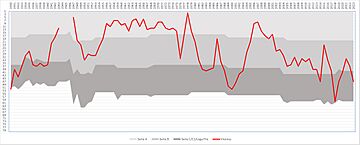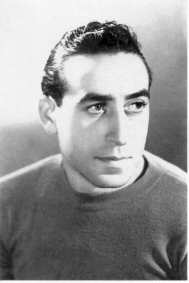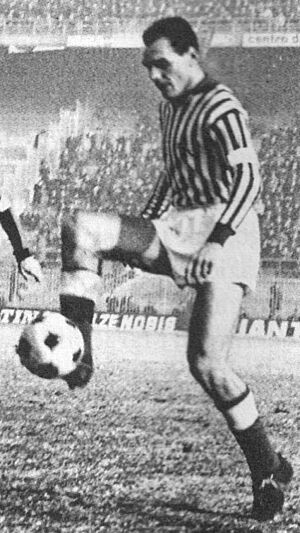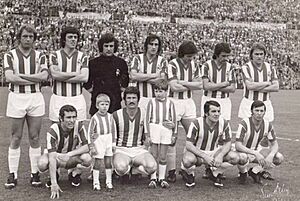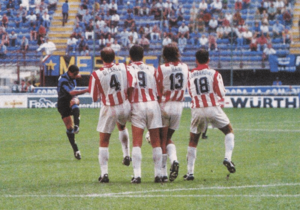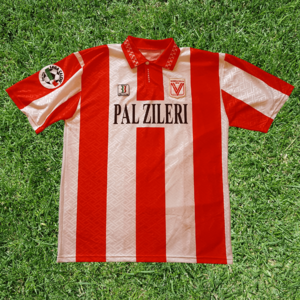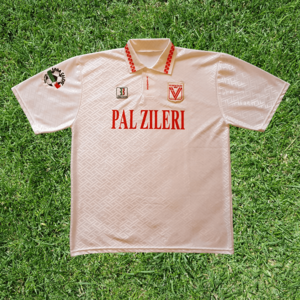LR Vicenza facts for kids
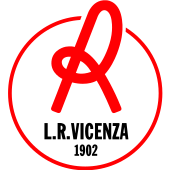 |
|||
| Full name | L.R. Vicenza S.p.A. | ||
|---|---|---|---|
| Nickname(s) | Biancorossi, Lanerossi/Lane, Nobile provinciale, I Berici | ||
| Founded | 9 March 1902 | ||
| Ground | Stadio Romeo Menti | ||
| Capacity | 12,000 | ||
| Owner | OTB Group S.p.A. | ||
| Chairman | Stefano Rosso | ||
| Head coach | Stefano Vecchi | ||
| League | Serie C Group B | ||
| 2018–19 | Serie C Group B, 8th of 20 | ||
|
|
|||
L.R. Vicenza S.p.A. is an Italian football club from the city of Vicenza. People often call them Vicenza or Lanerossi. They play in Serie C, which is the third level of Italian football.
The club started on March 9, 1902, as Associazione del Calcio in Vicenza. This makes it the oldest football club in north-eastern Italy. Vicenza has played 30 seasons in Serie A, Italy's top league. They are ranked among the best Italian teams of the 20th century by the IFFHS.
Vicenza has won the Italian Cup once (in 1997). They also won the Italian Cup Serie C twice, in 1982 and 2023. Their best international result was reaching the semi-finals of the UEFA Cup Winners' Cup in 1998. In 1911, they reached the final of the First Division championship. In 1978, they finished second in Serie A, which was amazing for a newly promoted team.
The club was restarted in 2018. This happened after the old Vicenza Calcio club went bankrupt. A team called Bassano Virtus moved to Vicenza and changed its name to L.R. Vicenza. This new club carries on the long history of football in Vicenza, which began in 1902.
Contents
- Club History: A Journey Through Time
- Rising Up: The 1930s and Romeo Menti
- Serie A Success and Post-War Return
- Lanerossi Vicenza: A New Era Begins
- Golden Years: Two Decades in Serie A (1955–1975)
- The "Real Vicenza" Season (1977–78)
- Vicenza Calcio: A New Name
- Winning the 1997 Italian Cup
- English Owners and European Adventures
- Challenges and Rebirth
- 2018: Bankruptcy and a New Beginning
- Team Colors and Symbols
- Stadium and Training Facilities
- Club Structure
- Youth Academy
- Team Achievements
- European Competitions
- League History
- Players
- Notable Former Coaches
- Kit Manufacturers and Sponsors
- Fans and Supporters
- See also
Club History: A Journey Through Time
Vicenza was founded in 1902 by Professor Tito Buy and teacher Antonio Libero Scarpa. It is one of Italy's oldest football clubs. The first board meeting was on March 9, 1902. Their first game was a friendly match on May 18, 1903.
The team started playing professionally in the 1910–11 season. They were called ACIVI back then. On February 12, 1911, they opened their new home ground, Borgo Casale, with a big win against Bologna. They reached the final for the national title but lost to Pro Vercelli.
Before World War I, Vicenza played in several national finals. They often faced big teams like Bologna, Juventus, Milan, and Inter. This showed they were one of Italy's top teams.
In the 1920s, Vicenza played in regional groups. They faced some tough times and even dropped to the fourth level of Italian football by 1929.
Rising Up: The 1930s and Romeo Menti
The 1930s were a time of comeback for Vicenza. In 1932–33, they were promoted to Serie B. They stayed there for two seasons and kept trying to reach Serie A. During this time, talented players like Romeo Menti and Piero Spinato emerged. Spinato is still the club's top scorer.
In 1939–40, they were promoted to Serie B again. A new stadium opened on September 8, 1935, along the Bacchiglione river. The first game there was against Hungarian team Soroksár. A 16-year-old Romeo Menti made his debut in that match. After Menti sadly died in the 1949 Superga air disaster, the stadium was named in his honor.
In the early 1940s, Vicenza reached Italy's top division. They had a strong midfield with players like Osvaldo Fattori and Alfonso Santagiuliana.
Serie A Success and Post-War Return
Vicenza's 1942–43 Serie A season ended with a great escape from relegation. They won their last game 6–2 against Juventus in Turin. After World War II, Vicenza returned to Serie A. In 1946–47, they surprisingly finished fifth. However, the next year, they finished last and were relegated. In 1949, they almost returned to Serie A but missed it by one point. The club then faced some financial problems in Serie B.
Lanerossi Vicenza: A New Era Begins
On June 26, 1953, the club's history changed. The old ACIVI was bought by Lanerossi, a big wool company. This was like a takeover, and the club became part of the textile company. They even put the company's name and the "R" symbol on their shirts. This "R" became a symbol of the club, even after the company left.
Players like Luís Vinício and Giulio Savoini became legends for Lanerossi in the 1950s.
Golden Years: Two Decades in Serie A (1955–1975)
With new money and confidence, Vicenza returned to Serie A in 1955. Coach Aldo Campatelli led them, and Enrico Motta scored many goals. They finished ninth, a great result for a promoted team. The youth team also won the famous Viareggio tournament twice in a row in 1954 and 1955. Many young talents from this team, like Azeglio Vicini and Mario David, later played for the main team.

In the late 1950s, they added South American players like Américo Murolo and Francisco Lojacono. Vicenza finished seventh twice in a row. In 1960–61, coach Roberto Lerici won an award for best coach. Lanerossi was known for being a smart club, focusing on young players and sometimes bringing in older, famous players.
In 1962, Brazilian striker Luís Vinício joined the team. In 1963–64, Vicenza was even first in the league for three weeks. Vinício had his best season in 1965–66, scoring 25 goals and becoming the league's top scorer. Lanerossi finished fifth that season.
However, after these great years, the team often struggled to avoid relegation. In 1972–73, they seemed sure to be relegated but won their last three games. They then won a play-off match against Atalanta. But in 1975, their luck ran out, and they were relegated to Serie B after 20 consecutive seasons in Serie A.
After a difficult 1975–76 season, coach Giovan Battista Fabbri had a brilliant idea. He changed young Paolo Rossi from a winger into a top striker. Rossi later led the Italian National Team to win the 1982 World Cup. Thanks to Rossi's goals and a strong team, Vicenza was promoted back to Serie A.
The "Real Vicenza" Season (1977–78)
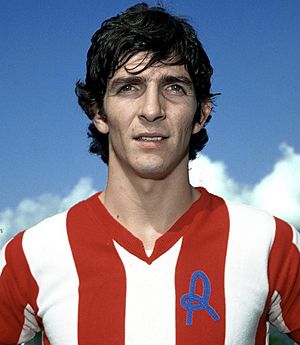
In the 1977–78 season, only Juventus did better than Lanerossi. The team finished second in the league, which was the best result ever for a newly promoted team. Paolo Rossi became a huge star. He was called up for the national team and was the league's top scorer with 24 goals. In 1978, Rossi played in the World Cup in Argentina.
After this amazing season, the club faced financial problems. They had to spend a lot of money to keep Rossi. This forced them to sell other good players. In 1978–79, they were knocked out of the UEFA Cup early. In Serie A, they struggled and were surprisingly relegated. Two years later, they even dropped to Serie C1. However, they won the Coppa Italia of Serie C in 1981–82.
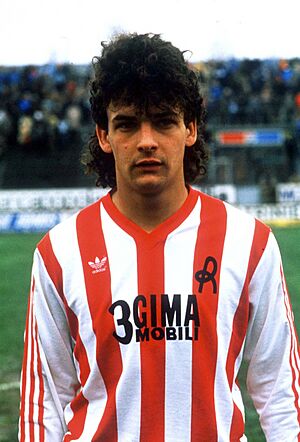
A young Roberto Baggio, who grew up near Vicenza, started his professional career with the club in 1984–85. He later became one of Italy's best players ever.
In 1985, Vicenza returned to Serie B. The next season, they almost reached Serie A again. But their promotion was canceled because of a betting scandal. This was a big blow, and in 1987, they fell back to Serie C1.
Vicenza Calcio: A New Name
In 1989, the club changed its name to Vicenza Calcio. They said goodbye to the "Lanerossi" name and its "R" symbol. The team had a tough time in 1989–90, almost being relegated to Serie C2. But they survived thanks to a play-off win and huge support from their fans.
They returned to Serie B in 1993. Coach Francesco Guidolin helped the team play well together. In 1994–95, they were promoted back to the top league, Serie A, finishing ninth.
Winning the 1997 Italian Cup

On May 29, 1997, Vicenza made history by winning the 1996–97 Coppa Italia. They had a great Serie A season, beating big teams like Juventus, Inter, and Milan.
In the Italian Cup final, they played Napoli. Vicenza lost the first game 1–0. But in the return match at their home stadium, Romeo Menti, they won 3–0 in extra time. This victory gave them the most important trophy in their history.
English Owners and European Adventures
In 1997, an English company, ENIC Group, bought Vicenza. This made Vicenza the first Italian team with foreign owners. As Italian Cup winners, they played in the Italian Super Cup but lost to Juventus.
In the 1997–98 season, Vicenza did well in Serie A and avoided relegation. They also surprised everyone by reaching the semi-finals of the UEFA Cup Winners' Cup. They only lost to Chelsea, who went on to win the competition. Pasquale Luiso was the top scorer in the cup for Vicenza.
After coach Guidolin left, the team was relegated to Serie B. But they quickly returned to Serie A by winning the 1999–2000 Serie B championship. However, their stay in Serie A lasted only one year. The 2000–01 season ended with relegation, which was Vicenza's last season in Italy's top league.
Challenges and Rebirth
In 2004, local business owners took over the club. For the next ten years, Vicenza mostly played in Serie B. They often narrowly avoided relegation. They were relegated to Serie C three times, but two of those were canceled due to problems with other teams.
In 2013, they were finally relegated to Italy's third league due to financial issues. In 2014–15, they almost returned to Serie A but lost in the play-offs. In 2017, the club was relegated to Serie C again, and their financial crisis worsened.
2018: Bankruptcy and a New Beginning
In 2018, Vicenza Calcio went bankrupt. They almost dropped to Serie D but won their relegation matches. The old club then officially stopped operating.
Later that year, businessman Renzo Rosso (who owns Diesel) bought the club's assets. He moved his other team, Virtus Bassano, to Vicenza. The team changed its name to L.R. Vicenza Virtus. This made them the new club carrying on Vicenza's football history. They stayed in Serie C for the 2018–19 season.
In the 2019–20 season, led by coach Domenico Di Carlo, Vicenza was declared the winner of their Serie C division. This was because the season ended early due to the COVID-19 pandemic. This meant official promotion back to Serie B.
In 2020–21, they easily avoided relegation from Serie B. On February 9, 2021, the club's name officially changed to L.R. Vicenza.
The 2021–22 season was tough. Vicenza struggled and was relegated to Serie C after losing a play-out match. In the 2022–23 season, they didn't perform as well as hoped in Serie C. However, on April 12, 2023, they won the Coppa Italia Serie C against Juventus Next Gen.
The 2023–24 season started slowly. But after coach Stefano Vecchi took over, the team had an amazing run of 23 games without losing. They reached the play-off final for Serie B promotion but lost to Carrarese.
Team Colors and Symbols
Since 1902, Vicenza's team colors have been white and red. These are the same colors as the city's flag. Their home uniform is usually a red and white striped jersey, white shorts, and white socks with red tips.
Over the years, the uniform has changed a lot. Early jerseys had very narrow stripes. In the 1920s and 30s, they sometimes wore white or red shirts with a horizontal band. After World War II, they used a wider range of colors.
From 1963 to 1967, they returned to thick stripes. Sometimes, they even wore a white jersey with a red diagonal stripe. In the 1970s, vertical stripes became standard again. The company Lanificio Rossi also provided simple second and third jerseys in bright colors like green, blue, and yellow, always with the classic "R" symbol.
In 1981–82, the first official sponsor, Yuma Jeans, appeared on the jerseys. From 1996 to 1999, the jerseys had fewer stripes.
The numbers and names on home jerseys were black until 2007. They have also been red, white, light blue, and gold.
In 1996–97, goalkeeper Luca Mondini wore some unique, colorful striped jerseys.
The 2001–02 season celebrated Vicenza's 100th anniversary. For this, Umbro created a classic jersey with the historic "R" and a golden "V" logo.
In 2008, a funny thing happened during a game. Vicenza's jerseys were too similar to the other team's. So, the team had to quickly buy new fluorescent yellow jerseys from a local shop!
In 2016–17, a special badge was added to the jersey to celebrate the 20th anniversary of their 1997 Italian Cup win.
Since 2020–21, the Vicenza provincial coat of arms is on the back of the shirts. It shows four World War I memorials and the city's flag.
The most famous jerseys are from the "Real Vicenza" team of 1977–78 and Francesco Guidolin's "Vicenza of miracles" from the mid-1990s.
|
Origins
|
1920–1930s
|
1930–1940s
|
1940–1960s
|
1960–1970s
|
1970s-present
|
|---|
Official Symbols
Team Badge
From 1902 to 1953, the club's symbol was a shield with a white cross on a red background, like the city's coat of arms. It also had white and red stripes and "A.C. VICENZA" written on it.
In 1953, after Lanerossi bought the club, the badge changed. It became a shield with "LANEROSSI A.C. VICENZA" at the top. At the bottom, on white and red stripes, was the famous knotted "R" symbol of the textile company.
The Lanerossi "R" was the only symbol on the team's jerseys until 1989.
In 1989, when the club became Vicenza Calcio, a new badge was designed. It was a white shield with a big red "V" that also looked like a cross, representing the city. "VICENZA CALCIO 1902" was written at the top.
The Lanerossi "R" returned to the jerseys in 2001–02 for the club's 100th anniversary. It became a "secondary crest" from 2006–07 onwards.
In 2018, after the bankruptcy, the new club L.R. Vicenza Virtus decided to use only the "R" as the main team crest again. A new logo was also created for official use, featuring the "R" inside a circle with "L.R. VICENZA 1902" below it.
Team Anthem
The club's official song is Inno biancorosso. It's the oldest and most important song for the fans, created in the early 1960s. The Lanerossi owners wanted a special song for the team. Fans still sing it at the stadium today. After the club restarted in 2018, this song became the official anthem again.
There are other songs too, like "Cuore biancorosso," sung by coach Francesco Guidolin and players in 1997 to celebrate their Italian Cup win.
Team Mascot
Vicenza has an official mascot named Gatton Gattoni. His story began in 1994–95. An advertising agency wanted to create a character for the team. They chose a cat wearing a Vicenza shirt.
When Vicenza was promoted to Serie A that season, Gatton Gattoni became the team's lucky charm. At first, he only appeared in newspapers and flyers. But then, a two-and-a-half-meter tall mascot was created to entertain fans at games. Gatton Gattoni first appeared on the field on May 12, 1996. He became very popular and even had his own merchandise. He was the first official mascot for a Serie A club. Gatton Gattoni continued to appear until the club went bankrupt in 2018.
Stadium and Training Facilities
Vicenza's first stadium was the Borgo Casale field. It was a simple field without stands. After World War I, the club looked for a new place to play.
In 1919, a new stadium was built in San Felice. It was modern for its time, with a wooden grandstand. It was nicknamed stadio dea carbonea (charcoal stadium) because they used charcoal to fix the field.
Since 1935, the team has played its home matches at the Stadio Romeo Menti. It was first called Campo Sportivo del Littorio. After being damaged in World War II, it was renovated and renamed Municipal in 1946.
In 1949, the stadium was named after Romeo Menti, a former Vicenza player who died in the Superga air disaster. The stadium has been updated many times. It's an "English-style" stadium, meaning the stands are very close to the field. In the 1970s, it could hold 30,000 fans. Today, it holds up to 12,000 spectators.
Training Center

From 2006 to 2017, the club used a modern training center in Isola Vicentina. It was named the Centro Tecnico Piermario Morosini after a former Vicenza player who sadly passed away.
This center had a large area with five football pitches, a gym, and medical rooms. It had separate areas for the first team and youth teams. After the club went bankrupt, the center was abandoned.
Since October 2021, the first team trains at the new Sporting Club 55. This center is owned by OTB Group, which controls the club. It's located in Fellette di Romano d'Ezzelino. The new facility has two football pitches with stands, synthetic grass pitches, padel courts, tennis courts, swimming pools, a gym, and a wellness area.
Club Structure
The club offices are located at Largo Paolo Rossi 9, inside the Stadio Romeo Menti area. Next to the offices is Casa Vicenza, a club house with a hospitality area and press room.
Company Ownership
L.R. Vicenza is a joint-stock company. Since May 29, 2018, it has been owned by the Vicenza-based OTB Group of entrepreneur Renzo Rosso. Other companies and entrepreneurs from Vicenza also own shares in the club.
Past Owners
- 1902–1953
 Shared player ownership
Shared player ownership - 1953–1989
 Lanerossi Spa
Lanerossi Spa - 1989–1997
 Pieraldo Dalle Carbonare
Pieraldo Dalle Carbonare - 1997–2004
 ENIC Group
ENIC Group - 2004–2016
 Finalfa Srl
Finalfa Srl - 2016–2017
 Vi.Fin. Spa
Vi.Fin. Spa - 2017–2018
 Vicenza bankruptcy court
Vicenza bankruptcy court - 2018–present
 OTB Group Spa
OTB Group Spa
Current Leadership
- President: Stefano Rosso
- General Manager: Werner Seeber
- Sports Director: Luca Matteassi
- Sports Secretary: Simone Marconato
- Management Secretary: Sofia Pagiusco
- Finance Manager: Elisabetta Alzeni
- Administration: Federico Marchesini, Stefano Bizzotto
- Communication and Marketing Manager: Sara Vivian
- Graphics: Stefano Sartore
- Digital account: Francesco Salomon
- Merchandising: Luca Franceschini
- Sales Manager: Nicola Rossi
- Sales: Vladimiro Arcoma, Federico Hanard
- Marketing and Sales Secretariat: Giovanni Cittadin
- Scouting: Riccardo Polacco
- Ticketing: Giulia Pozzan
- Switchboard: Milica Stevanovic
- Stadium and Logistics: Sergio Valerio, Roberto Filippi, Elena Giavatto
- Warehouse: Ivana Spallino, Fabrizio Zordan, Paola Marenda
- Security Delegate: Gianluca Miozzi
- R.S.P.: Giuseppe Gangi
- S.L.O.: Michele Zanotto
Youth Academy

Vicenza's youth academy is very successful. They won the Viareggio Tournament twice in a row, in 1954 and 1955.
The academy has different levels:
- Competitive teams: For older youth players (U13 to Primavera).
- Grassroots activities: For younger players (Beginners and Pupils).
- Football School: For very young children (5-8 years old).
- Vicenza Academy: A network of almost 40 football clubs in the Veneto region that work with LR Vicenza to find and develop young talent.
Many famous players started in Vicenza's youth academy. These include Roberto Baggio, who is considered one of the best players ever. Other notable players are Gino Vallesella, Umberto Menti, Romeo Menti, Luigi Menti, Alberto Marchetti, Bruno Quaresima, Mirko Pavinato, Nevio Scala, Massimo Briaschi, Giorgio Sterchele, Nicola Zanini, Paolo Zanetti, and Luca Rigoni.
Christian Maggio, who grew up in Vicenza's youth system, made his debut for the first team in 2000–01. He later became a key player for other teams and the national team.
The youth teams train at various facilities in Vicenza and Bassano. Many former Vicenza players now coach in the youth academy.
Current Youth Academy Staff
- Sector Manager: Michele Nicolin
- Youth Sector Secretary: Gabriele Stevanin
- Responsible for Basic Activities Area Vicenza: Davide De Pretto
- Responsible for Basic Activities Area Bassano del Grappa: Claudio Conte
- Youth Sector Technical Manager: Lorenzo Simeoni
- Responsible for the Football School: Luigi Zanetti
- Primavera Coach: Lorenzo Simeon
- Assistant Coach: Andrea Rabito
- Managers: Giuseppe Sammarco, Bortolo Broglio, Fulvio Benetti, Rino Quagliato
- Athletic trainers coordinator: Paolo Guderzo
- Goalkeeping trainers: Carlo Gelmetti, Massimo Mattiazzo, Mirko Muraro
- Doctor: Dr. Paolo Vialetto
- Physiotherapists: Dr. Agostino Padovan, Dr. Paolo Dal Ferro
- Injury prevention and recovery: Beniamino Dalla Riva
- Videoanalysts: Lorenzo Favaro, Alvise Scarpa
- Sport mental trainer: Guido Bresolin
- Under-17 coach: Luca Rigoni (former Vicenza player)
- Under 16 coach: Guido Belardinelli
- Under 15 coach: Diego Bistore
Team Achievements
National Trophies
Cups
- Coppa Italia
- Winners: 1996–97
- Coppa Italia Serie C
- Winners: 1981–82, 2022–23
Leagues
International Trophies
- Benelux Cup
- Winners: 1961
- Uhrencup
- Winners: 1965
European Competitions
UEFA Cup Winners' Cup
| Season | Round | Club | Home | Away | Aggregate |
|---|---|---|---|---|---|
| 1997–98 | First Round | 2–0 | 1–1 | 3–1 | |
| Second Round | 2–1 | 3–1 | 5–2 | ||
| Quarter-finals | 5–0 | 4–1 | 9–1 | ||
| Semi-finals | 1–0 | 1–3 | 2–3 |
UEFA Cup
| Season | Round | Club | Home | Away | Aggregate |
|---|---|---|---|---|---|
| 1978–79 | First round | 1–1 | 0–1 | 1–2 |
Source:
League History
| Series | Years | Last Season | Promotions | Relegations |
|---|---|---|---|---|
| A | 30 | 2000–01 | - | |
| B | 37 | 2021–22 | ||
| C | 24 | 2023–24 | ||
| 91 out of 92 years of professional football in Italy since 1929 | ||||
| Founding member of the Football League's First Division in 1921 | ||||
| D | 1 | 1929–30 | never | |
Players
Current Squad
|
|
Players on Loan
|
Retired Jersey Numbers
3– ![]() Giulio Savoini 25–
Giulio Savoini 25– ![]() Piermario Morosini, (2007–09, 2011)– honored after his passing.
Piermario Morosini, (2007–09, 2011)– honored after his passing.
Famous Former Players
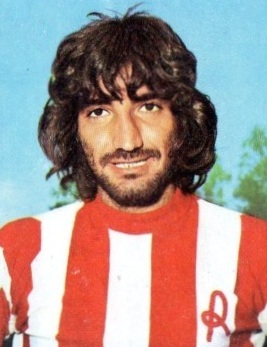
Notable Former Coaches
Vicenza has had 75 coaches since 1902, mostly Italian.
The first coach was Antonio Libero Scarpa (1902–1908). Giulio Fasolo coached the team for the longest, 10 seasons. He was coach when Vicenza almost won the Scudetto in 1910–11.
Many foreign coaches led the team in the 1920s and 30s, like Austrian Franz Sedlacek. The Hungarian coaches Wilmas Wilhelm and Imre Janos Bekey, and Uruguayan Hector Puricelli, had the most games.
Giovan Battista Fabbri was a very important coach (1976–1979). He led Vicenza to almost win Serie A in 1977–78. He famously changed Paolo Rossi into a top striker.
Francesco Guidolin coached Vicenza from 1994 to 1998. He won the 1996–97 Coppa Italia and reached the semi-finals of the 1997–98 UEFA Cup Winners' Cup. He focused on teamwork.
Under Edoardo Reja, the team was promoted to Serie A for the last time in 1999–2000.
Some players also became coaches for Vicenza, including Giulio Fasolo, Umberto Menti, Roberto Lerici, Chinesinho, Giulio Savoini, Giovanni Lopez, Nicola Zanini, and Domenico Di Carlo.
Here is a list of coaches from the club's beginning:
 Otto Krappan (1933–34)
Otto Krappan (1933–34) József Viola (1934–36)
József Viola (1934–36) András Kuttik (1937–39)
András Kuttik (1937–39) Elemér Berkessy (1948–49)
Elemér Berkessy (1948–49) Alfredo Mazzoni (1950–51)
Alfredo Mazzoni (1950–51) Fulvio Bernardini (1951–53)
Fulvio Bernardini (1951–53) Aldo Campatelli (1954–55)
Aldo Campatelli (1954–55)
 Béla Guttmann (1955–56)
Béla Guttmann (1955–56) Roberto Lerici (1957–62)
Roberto Lerici (1957–62) Giovanni Varglien (1957–58)
Giovanni Varglien (1957–58) Aldo Campatelli (1965–66)
Aldo Campatelli (1965–66) Umberto Menti (1967)
Umberto Menti (1967) Arturo Silvestri (1967–68)
Arturo Silvestri (1967–68) Umberto Menti (1968)
Umberto Menti (1968) Ettore Puricelli (1969–71)
Ettore Puricelli (1969–71) Umberto Menti (1971–72)
Umberto Menti (1971–72) Ettore Puricelli (1973–75)
Ettore Puricelli (1973–75) Chinesinho (1976)
Chinesinho (1976) Giovan Battista Fabbri (1976–79)
Giovan Battista Fabbri (1976–79) Renzo Ulivieri (1979–80)
Renzo Ulivieri (1979–80) Giancarlo Cadé (1981–83)
Giancarlo Cadé (1981–83) Bruno Mazzia (1982–83)
Bruno Mazzia (1982–83) Bruno Giorgi (1983–86)
Bruno Giorgi (1983–86) Tarcisio Burgnich (1986–87)
Tarcisio Burgnich (1986–87) Romano Fogli (1989–90)
Romano Fogli (1989–90) Renzo Ulivieri (1991–94)
Renzo Ulivieri (1991–94) Francesco Guidolin (1994–98)
Francesco Guidolin (1994–98) Franco Colomba (1998–99)
Franco Colomba (1998–99) Edoardo Reja (1998–01)
Edoardo Reja (1998–01) Eugenio Fascetti (2001–02)
Eugenio Fascetti (2001–02) Adelio Moro (2001–02)
Adelio Moro (2001–02) Andrea Mandorlini (2002–03)
Andrea Mandorlini (2002–03) Giuseppe Iachini (2003–04)
Giuseppe Iachini (2003–04) Gianfranco Bellotto (2004–05)
Gianfranco Bellotto (2004–05) Giancarlo Camolese (2005–06)
Giancarlo Camolese (2005–06) Angelo Gregucci (2006–09)
Angelo Gregucci (2006–09) Rolando Maran (2009–11)
Rolando Maran (2009–11) Nedo Sonetti (2010)
Nedo Sonetti (2010) Silvio Baldini (2011)
Silvio Baldini (2011) Luigi Cagni (2011–12)
Luigi Cagni (2011–12) Massimo Beghetto (2012)
Massimo Beghetto (2012) Luigi Cagni (2012)
Luigi Cagni (2012) Roberto Breda (2012–13)
Roberto Breda (2012–13) Alessandro Dal Canto (2013)
Alessandro Dal Canto (2013) Giovanni Lopez (2013–14)
Giovanni Lopez (2013–14) Pasquale Marino (2014–16)
Pasquale Marino (2014–16) Franco Lerda (2016)
Franco Lerda (2016) Pierpaolo Bisoli (2016–17)
Pierpaolo Bisoli (2016–17) Vincenzo Torrente (2017)
Vincenzo Torrente (2017) Alberto Colombo (2017)
Alberto Colombo (2017) Nicola Zanini (2017–18)
Nicola Zanini (2017–18) Franco Lerda (2018)
Franco Lerda (2018) Nicola Zanini (2018)
Nicola Zanini (2018) Giovanni Colella (2018–19)
Giovanni Colella (2018–19) Michele Serena (2019)
Michele Serena (2019) Giovanni Colella (2019)
Giovanni Colella (2019) Domenico Di Carlo (2019–21)
Domenico Di Carlo (2019–21) Cristian Brocchi (2021–22)
Cristian Brocchi (2021–22) Francesco Baldini (2022)
Francesco Baldini (2022) Francesco Modesto (2022–23)
Francesco Modesto (2022–23) Dan Thomassen (2023)
Dan Thomassen (2023) Aimo Diana (2023)
Aimo Diana (2023) Stefano Vecchi (2023–)
Stefano Vecchi (2023–)
Kit Manufacturers and Sponsors
Kit Manufacturers
- 1970–1971 Umbro
- 1978–1992 Adidas
- 1992–1995 Virma
- 1995–1997 Biemme
- 1997–1998 Lotto
- 1998–1999 Biemme
- 1999–2002 Umbro
- 2002–2005 Biemme
- 2005–2007 A–Line
- 2007–2009 Diadora
- 2009–2012 Max Sport
- 2012–2018 Macron
- 2018–2022 Lotto
- 2022–present Fila
Sponsors
- 1981–1984 Yuma Jeans
- 1984–1985 TreGima Mobili
- 1985–1987 Acqua Recoaro
- 1987–1989 Pulitalia
- 1989–1998 Pal Zileri
- 1998–1999 Belfe
- 1999–2000 Caffè Vero
- 2000–2002 Artel
- 2002–2005 Caffè Vero
- 2005–2007 Acqua Recoaro
- 2007–2009 Fiera di Vicenza
- 2009–2010 Fiamm
- 2010–2017 Banca Popolare di Vicenza
- 2017–2018 Acciaierie Valbruna
- 2018– Diesel
Fans and Supporters
Vicenza has many fans in Italy and around the world.
The organized fan movement, called "ultras," started in Vicenza in 1974 with the group Ultras. Another group, I Marines, formed in 1975. Both groups used a skull as their symbol. The Vigilantes were a main group from 1978 until 2012. Their symbol was a hooded figure.
Other historical groups included the Fabio Group, Caneva Berica, and Kapovolti. The Fabio Group was created in 1990 to remember a fan named Fabio Cucco. The Vecchia Guardia (Old Guard) group was formed in the late 1980s by the founders of the Vigilantes.
Today, the main groups in the Curva Sud (South Stand) are South Terrace, Lanerossi Crew 1902, Lanerossi Youth, Banda Thiene, Caneva Berica, and Vecchia Guardia.
Friendships and Rivalries
Vicenza fans have strong friendships with fans of other teams. Their first friendship was with Pescara fans, starting on January 9, 1977. They are also friends with Reggiana (since 1982), Cremonese (since 1984), Udinese (since the 1980s), and FC Metz (since 1997). Internationally, they are friends with Millwall (since 2015), Olympique Lyon, and Vigor Lamezia.
Vicenza has a very strong rivalry with Hellas Verona. Their matches are called the "derby of Veneto" and are the biggest football rivalry in the region. This rivalry goes back to conflicts between the cities of Vicenza and Verona in the Middle Ages.
Another big rivalry is with Napoli. This rivalry became even stronger in the mid-1990s, with incidents during matches. For example, in the 1997 Coppa Italia final, there were fights and flares thrown by fans.
Other historical rivalries include those with Padova, Brescia, Triestina, SPAL, Cesena, Bologna, Atalanta, and Venezia.
They also have rivalries with Italy's "big three" clubs: Juventus, AC Milan, and Inter Milan. The rivalry with Juventus grew stronger in 1996.
Internationally, their only notable rivalry is with Chelsea. This started in 1998 during the UEFA Cup Winners' Cup semi-final.
|
See also
 In Spanish: L.R. Vicenza para niños
In Spanish: L.R. Vicenza para niños


